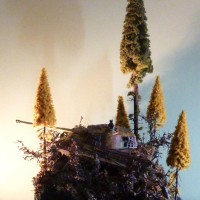Belgian Thoroughbred
In 1930 the Belgians were considering what their new fighter aircraft was to be. They'd held a competition and settled on the rather pedestrian Dewoitine D.27 and the Czech Avia BH-33. However, the air force staff attended the Hendon Air Show that year and were dazzled by the performance of the Fairey Firefly IIM prototype. This was something they had to have, it was more expensive and hadn't been in the competition but was even better. The Firefly had been the loosing aircraft in the RAF's own competition, being beaten by the Hawker Fury though some believed the latter wasn't as manoeuverable or as fast. Be that as it may the Fury was judged more suitable for RAF squadron service so the Firefly was available. Fairey quickly got a Firefly over to Belgium for the Belgians to try out and that clinched it - they wanted Firefly and nothing else. Fairey even helped things along by agreeing to build the aircraft in Belgium after the first 25 had been delivered. The Firely was a very 'hot ship' and aerobatics had to be banned in it until the Belgians could establish an advanced training unit so that pilots could get used to the machine. Once they did it served Belgium very well but, of course, was obsolete by the World War II.
I've always liked the lines of the Firefly and there are 2 kits available in 1/72. The old Aeroclub kit which is very much a short run effort and is only recommended for experienced modellers and the newer Kora kit. Both have their advantages and disadvantages. As I said the Aeroclub kit is definitely short run and whilst accurate and capturing the looks of the Firefly is simplified. It does however represent an early non-license built Firefly but is difficult to find. The Kora kit has heavier detail but a lot of this is appropriate for the license-built aircraft (which is what the Kora kit represents) which had heavier panelling on the fuselage in particular. However, some of the Kora detail is too heavy especially the fuel tank on the upper wing. The Kora kit also comes with an etched brass sheet. It is also expensive for what it is.
As I wanted to build an early Firefly I chose the Aeroclub kit - these are still available but come up on ebay infrequently. An American supplier was able to help me out and after some delay the kit arrived. It is truely short run - thick (but easily workable plastic and white metal parts. However, one has to do a lot of research to add the necessary detail to the model. The Belgian Wings website (despite it's many flaws) was a great help here. I rapidly realised that one wasn't going to be able to achieve Tamiya level quality so concentrated on getting the best result I could from the material. I chose aircraft Y-3 from 2-I-2 'Chardon' squadron - the first one to serve with the squadron and one of the first batch of aircraft delivered from England.
The colour scheme was different for these early aircraft with, as the pictures show, green upper surfaces and a matt finish to the upper wing. I had to scratch the cockpit and add a considerable amount of detail to the fuselage and under wings. The exhaust outlet shape isn't strictly correct but there was nothing available that could replicate that shape. I used some Eduard control wire inlet outlines to represent the barely visible pipes.
The Aeroclub decals were usable and went down well. I had to scrounge around though, for decals small enough for the aircraft number (F1491). I was able to omit the upper wing roundels as the early aircraft didn't carry them. I had initially hoped to make aircraft Y-1 from 1-I-2 'Comete' but Aeroclub had gotten the squadron symbol wrong and alternative decals are thin on the ground. Rigging was .15 mm brass wire and this was actually very nice to work with. The model was painted with Humbrol 155 for the green areas which was semi-gloss varnished as appropriate. The Aluminium front was Tamiya XF-16 flat aluminium enamel (also semi-gloss varnished) and the doping Tamiya X-11 chrome silver enamel. It's not my best but it is one of the most satisfactory models I've built and I frequently find this with Aeroclub models. Lots of challenges and patience was needed but I now have an early Firefly. It looks very nice next to the Fury and John Adams has certainly captured the elegant lines of this fighter.








Nice work on the model, and thanks for the interesting history.
Many thanks George - the history of these aircraft is interesting and as I said some believe the RAF got the wrong choice for their interceptor.
Very nice work on an obscure aircraft! Looks great.
Thanks ever so much Greg - I do like doing models of obscure aircraft especially such nice looking ones as these.
Another amazing build after supreme research, Christopher! Thanks for all historical facts!
Thanks ever so kindly Spiros - the interwar inline biplane fighters are fun to build and great fun to research.
Very nice work and great historical description, Christopher @christopher
Well done.
Thank you once again for your kind comments John @johnb. It's always nice to hear one's efforts appreciated so kindly.